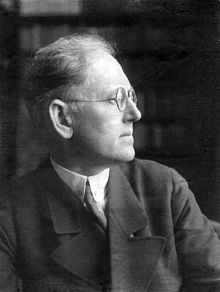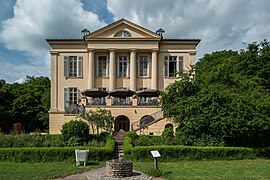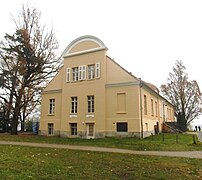Paul Schultze-Naumburg

Paul Schultze-Naumburg (10 June 1869 – 19 May 1949) was a German traditionalist architect, painter, publicist and author. A leading critic of modern architecture, he joined the Nazi Party in 1930 (aged 61) and became an important advocate of Nazi architecture.
Life
Schultze-Naumburg was born in Almrich (now part of
On 5 January 1922, Paul Schultze-Naumburg married in Saaleck Margarete Karolina Berta Dörr (1896–1960). They were childless and divorced unpleasantly on 7 February 1934. A couple of weeks later, Margarete married the Reich Minister of the Interior Wilhelm Frick.[1]
In response to Germany's defeat in the
Along with
In September 1944, Schultze-Naumburg was named in the Gottbegnadeten list as one of the first rank of artists and writers important to Nazi culture.
Schultze-Naumburg died in
Works
In addition to his publications mentioned above, others are here. This is not a complete list. His books were very popular, were reprinted many times, and remain available today.
- Häusliche Kunstpflege (Leipzig 1900).
- Kunst und Kunstpflege (Leipzig 1901).
- Technik der Malerei: ein Handbuch fur Kunstler und Dilettanten (1901)
- Kulturarbeiten (1904)
- Das Studium und die Ziele der Malerei (1905)
- Die Entstellung unsres Landes (Munich 1908)
- Die Kultur des weiblichen Körpers als Grundlage der Frauenkleidung (Jena 1912)
- Die Gestaltung der Landschaft durch den Menschen. Zweiter Band: III: "Der geologische Aufbau der Landschaft und die Nutzbarmachung der Mineralien IV. Die Wasserwirtschaft" (Munich 1922/8)
- Flaches oder geneigtes Dach? : mit einer Rundfrage an deutsche Architekten und deren Antworten (Berlin 1927)
- Kunst und Rasse, Munich 1928, 4th edition 1942
- Bildmäßige Photographie, Mit 60 Bildbeispielen (Munich 1938)
- Die Kultur des Weiblichen Körpers als Grundlage der Frauenkleidung
Selected projects
-
Schloss Hackhausen in Solingen
-
Schloss Bahrendorf in Sülzetal
-
Guest house in Kladow
-
Manor in Grabow
-
Country home in Potsdam
See also
Bibliography
- Jose-Manuel GARCÍA ROIG, "Tres arquitectos del periodo guillermino. Hermman Muthesius. Paul Schultze-Naumburg. ISBN 978-84-8448-370-0, Universidad de Valladolid, Spain
References
Notes
- ^ "Familie Paul Schultze-Naumburg“
- ^ Adam, pp. 29–32
- ^ Grosshans, p. 9
- ISBN 0-19-507219-7.
Sources
- Adam, Peter. Art of the Third Reich (1992). New York: ISBN 0-8109-1912-5
- Barron, Stephanie, ed. 'Degenerate Art:' The Fate of the Avant-Garde in Nazi Germany (1991). New York: Harry N. Abrams, Inc.. ISBN 0-8109-3653-4
- Grosshans, Henry. Hitler and the Artists (1983). New York: Holmes & Meyer. ISBN 0-8419-0746-3






